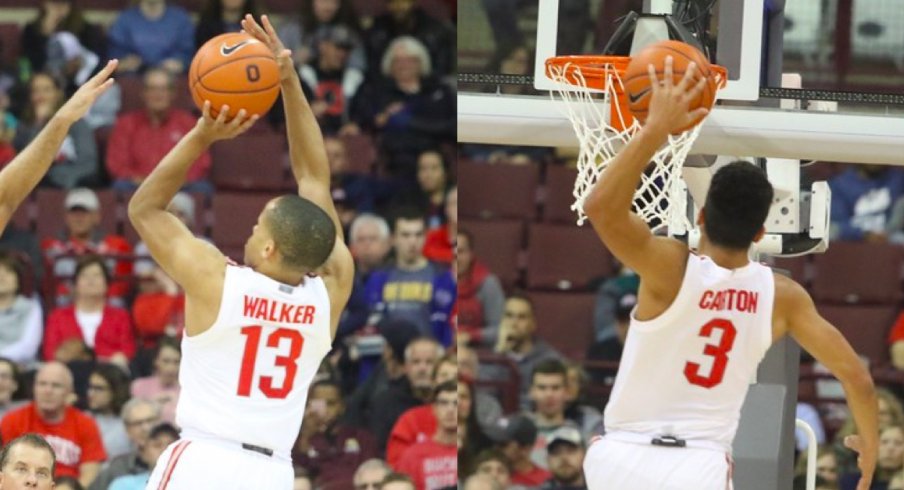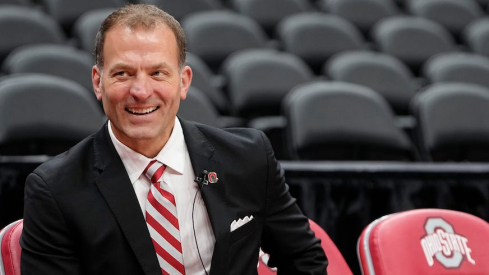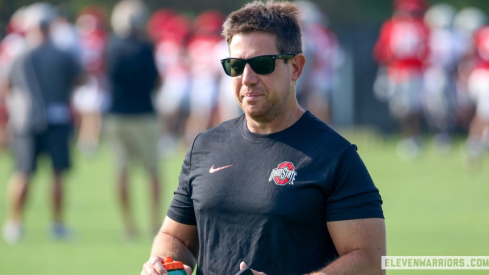Kaleb Wesson remains the focal point of Chris Holtmann's offense.
The big man enters his junior season as not only one of the nation's most experienced big men in terms of games played but touches as well. As a sophomore, the 6'9" post player had a usage rate of 29.7%, meaning nearly a third of all plays involved him as the shooter or setup man while he was on the floor.
But although it certainly felt like everything ran through the Buckeye big man last season, senior guards C.J. Jackson and Keyshawn Woods were nearly as pivotal, especially during the season's final month when Woods' role increased. The duo not only played a great deal together, but they shared ballhandling duties and often looked to set one another up in Holtmann's structured system.
For example, thanks to the attention afforded Wesson, even as he dived to the rim in a high screen-and-roll, Jackson was able to find a wide-open Woods in this clip from last year's NCAA tournament matchup with Houston:
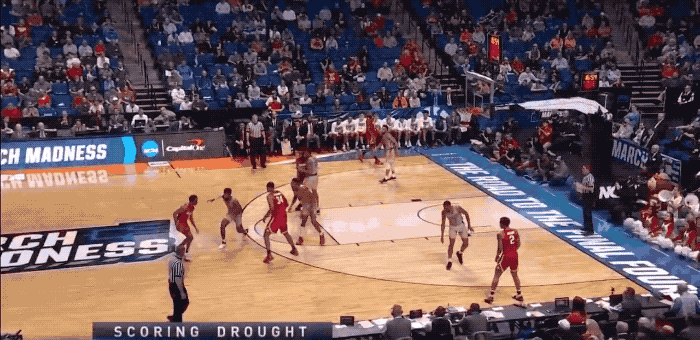
But thanks to their relative scoring prowess, especially Jackson's 37% shooting from 3-point range, Holtmann often called their numbers in half-court sets. One of his favorites was a designed action away from a Wesson post-up:
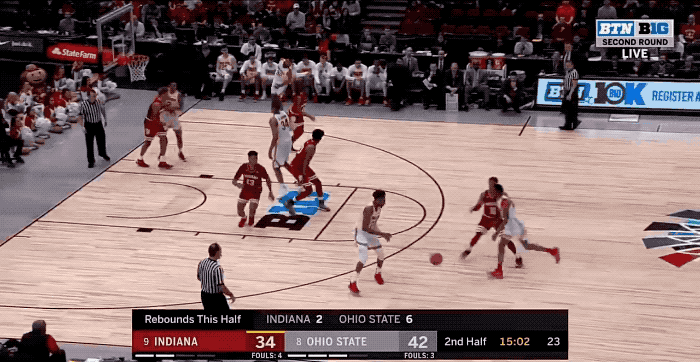
After Wesson sets a screen for Musa Jallow on the strong-side block, Jallow immediately looks to feed the big man after catching a pass at the top of the key from the power forward, Andre Wesson. With the post-entry denied, however, Andre sets a screen off the ball for Jackson, setting him up for an easy catch-and-shoot three off the pass from Jallow.
Both Jackson and Woods benefited from these off-ball screens, setting them up for open scoring chances. But these actions were the result of one of the nation's slowest tempos, as the Buckeyes ranked 274th out of 351 division-1 programs in adjusted pace last winter.
With Walker and Carton now acting as the lead ballhandlers, Holtmann expects the duo to inject some explosiveness into his attack.
“I think the pace of play with our point guards, they've provided some things for us that are just a little bit different in terms of their ability to get from zero to 60, and we need that,” Holtmann said last month at Big Ten media day. “I think we need to be able to touch the paint and threaten the paint more than what we did last year.”
In the preseason exhibition against Cedarville, Carton and Walker did just that. Midway through the first half, Carton could've easily walked the ball up and look to Holtmann for a play-call following a made basket.
Recognizing the defense was still setting up as he crossed half-court, however, Carton raced to the rim for an easy layup.
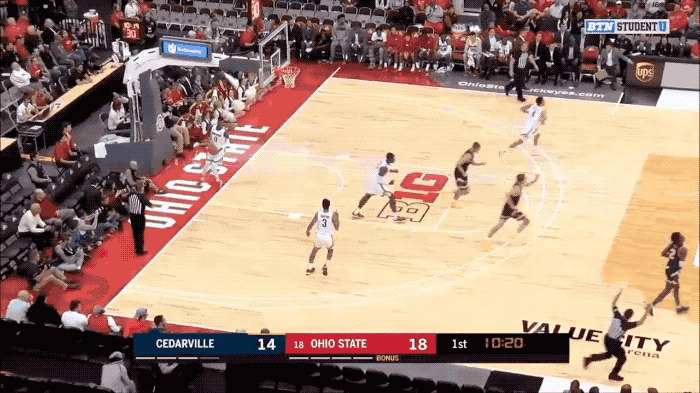
“Every time I get the ball, I'm going to push it just because I know that that's one of my strengths, and I know tonight sometimes defense wasn't set and stuff like that, and I know we can get easy buckets like that,” Carton said of the play in a postgame press conference.
Once in their half-court offense, though, the duo created scoring chances for themselves and their teammates. Whether it was Carton creating space off a high screen-and-roll with a nice step-back move...
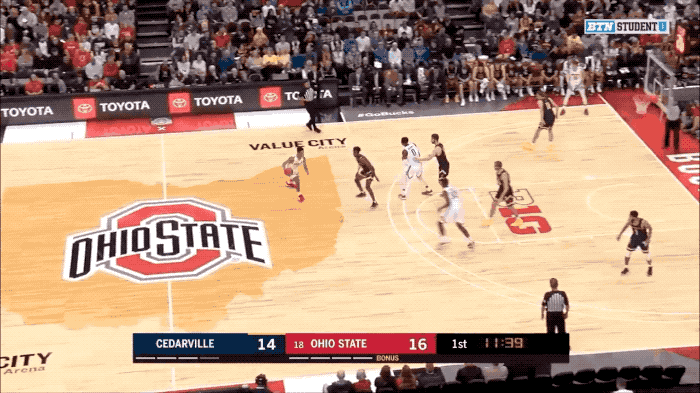
...or Walker lacing a pass to a backdoor cutter, the offense wasn't so reliant on intricate plays called from the sideline.
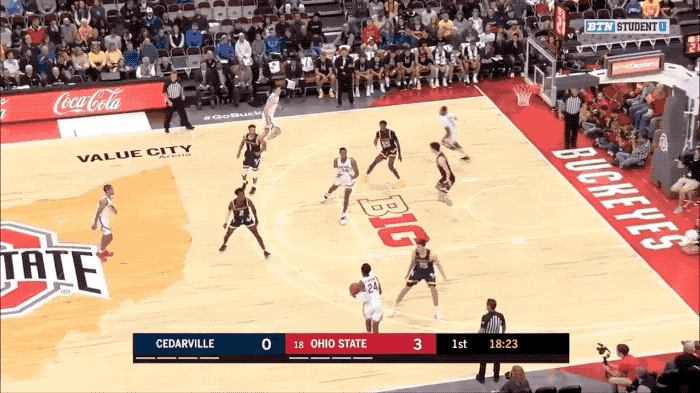
“We just could not get enough easy scores last year," Holtmann said last month. "Whether in the half-court or certainly in the open floor, it was so hard for us to manufacture against a good defense.”
Both guards have shown an ability to match the shooting prowess of Jackson and Woods, as Walker shot 35.5% from 3-point range in his sophomore year at Florida State before transferring while Carton looked quite comfortable as he drained his only attempt from deep against Cedarville.
One major way in which the backcourt duo can manufacture points is in transition, where their speed and athleticism is a big difference from a year ago.

“Obviously with the guards that we have now, they're a lot quicker, a lot faster, so we'll definitely see us playing faster, for sure,” Andre Wesson said last month. “For guys like me, it just makes it easier for me to run to the wing or run in transition and get easier baskets.”
But the big question remains how the pair will share minutes as the only two true point guards on the roster. In the few moments where both players were on the floor, they showed just how explosive this team can be as they pushed the pace in the open floor off a turnover.

Last year's rotation took months to solidify as Woods didn't emerge as a major contributor opposite Jackson until February when it became clear that the team's best scoring options were in this true two-guard set.
“We'll play those two together, as well. So we don't always look at it as an either-or situation. I think there will definitely be times when they play together.”
Perhaps the most critical element in determining rotations will be either guard's ability to mesh with Wesson, the team's best and most important player. Though Walker started the game along with the big man, Carton saw nearly twenty minutes of playing time in the exhibition and impressed his coach in the process.
“DJ, I thought, made really good reads off of some of that stuff,” Holtmann said of Carton's time running the offense. “So I think that'll continue to be a theme. We have to be a group that is more diverse in a lot of ways offensively, and I think you'll see that throughout the season that we're going to need contributions from a lot of guys in various games, but that was something that was really good for us in this game.”
Ultimately, this team's success will hinge on Wesson's ability to stay on the floor and score both inside and out. But in order to escape the first weekend of the NCAA tournament for the first time in Holtmann's tenure, Carton and Walker must eclipse the productivity of their predecessors.
